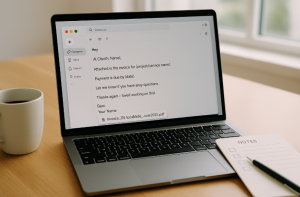You’ve done the work. The client’s happy. The project’s done and dusted. But your bank account? Still patiently waiting. And then comes the classic message: “Hey, can you send over an invoice?” If your heart sinks and your palms get sweaty at the mere mention of it — don’t worry. You’re not alone.
Writing and sending invoices might sound boring (okay, it is), but it’s also 100% necessary if you want to get paid like a pro. A good invoice makes you look professional, organized, and, let’s face it, way more put-together than you probably feel at the end of a project. Let’s make the whole process easy, fast, and — dare we say — kinda satisfying.
What Should an Invoice Include?
Let’s keep this simple. An invoice doesn’t have to be fancy, but it does need to be clear. No weird fonts, rainbow backgrounds, or Excel files from 2003. Just the essentials, laid out in a way that makes sense — even to a sleep-deprived accountant.

Here’s what every proper invoice needs:
- Your details: name, business name (if applicable), phone, email, and address
- Client info: who you’re invoicing — name, company, email, etc.
- Unique invoice number: make it something trackable (e.g. #2025-06-01)
- Issue date and due date: so everyone’s on the same timeline
- List of services/products: what you did, how much it costs, and how many units/hours/etc.
- Total amount due: this is what they’ll actually pay
- Payment instructions: bank info, PayPal, Wise, card link — whatever works
- Optional note: like “Thank you!” or “Let me know if you need anything else”
That’s it. Keep it clean, to the point, and don’t make your client play detective just to figure out how to pay you.
Where to Create Your Invoice Without Losing Your Mind
Yes, technically you could open Word or Excel and try to design one from scratch. But why suffer when better tools already exist?
Some easy (and free) ways to create a solid invoice:
Google Docs or Sheets — Great for no-frills, clean-looking invoices. Use a template, tweak the info, export as PDF, and done.
Canva — If you want it to look modern and branded without being a graphic designer. Tons of pre-made invoice templates, drag-and-drop easy.
Free tools like Wave, Zoho Invoice, or Invoice Generator — These create invoices, track when they’re viewed, and some even let you get paid directly. Fancy, huh?
Just avoid overcomplicating things. You don’t need a 12-tab Excel monster or a PDF called invoice_FINAL_FINAL_revised2.pdf. Keep it simple, friend.
Sending Your Invoice Without Looking Like a Spam Bot
Now comes the part where many people drop the ball: sending it.
Please don’t just attach the invoice and hit send with no message. That’s how invoices get buried in inboxes or mistaken for spam. A short, friendly message adds a human touch — and people are more likely to pay humans than mysterious attachments.

Here’s an example of what to write:
Hey [Client’s Name]!
Attached is the invoice for [project/service name].
Payment is due by [date]. Let me know if you have any questions. Thanks again — loved working on this!
Best,
[Your Name]
Also, name your file something that makes sense: Invoice_203_SocialMedia_June2025.pdf is 100x better than doc(6).pdf. Be kind to your client’s inbox.
Quick Checklist Before You Hit Send
If you’re running on caffeine and muscle memory, here’s a rapid-fire rundown of what to check before you send that invoice off into the world:
- Invoice number and date are correct
- Client’s name and info are accurate
- Services and amounts are clearly listed
- Total due is right (double-check your math!)
- Your payment details are included
- You’ve saved it as a PDF (not editable)
- The filename is clean and clear
- You included a short message in the email
Nail all of that, and your invoice isn’t just a form — it’s a confidence flex.
Can an Invoice Be Fun? Honestly, Yes
If you work in a creative field or with relaxed clients, who says invoices have to be cold and corporate? Adding a personal touch can make you memorable — in a good way.
Try including a friendly note like:
- “Thanks for trusting me with this — you rock!”
- “Paying this invoice adds +10 to your karma score.”
- “Looking forward to next time already!”
People remember how you made them feel — even in business. And hey, they’re more likely to pay quickly when they like you.
Wrapping Up: Professional Vibes = Faster Payments
Invoices aren’t just paperwork. They’re the final piece of your work — the official “here’s what we did, and here’s how we settle up” moment. When done right, they reinforce that you’re organized, reliable, and worth every penny.
So don’t leave your money in limbo. Make invoicing part of your workflow, not an afterthought. Set up a solid template, create a checklist, and send that thing like the absolute pro you are.
And next time someone says “just send me an invoice,” you’ll smile — because you’ve got it covered.